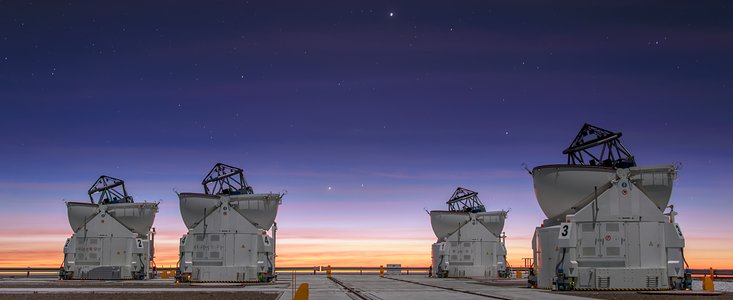Annuncio
Prima luce di NAOMI
Nuovo modulo di ottica adattiva all'avanguardia per l'interferometro del VLT dell'ESO
07 Dicembre 2018
NAOMI, il nuovo modulo di ottica adattiva per interferometria (o New Adaptive Optics Module for Interferometry in inglese) ha visto la prima luce dopo essere stato installato su tutti e quattro i telescopi ausiliari (AT) di 1,8 metri di diametro del VLTI (Very Large Telescope Interferometer) dell'ESO presso l'Osservatorio del Paranal in Cile. Con l'introduzione di una tecnologia di ottica adattiva all'avanguardia, NAOMI ha migliorato le capacità di imaging del VLTI a livelli senza precedenti, offrendo ai potenti strumenti scientifici come GRAVITY una visione dell'Universo più nitida che mai.
Il VLTI è una modalità del VLT (Very Large Telescope) dell'ESO che può combinare anche tutti a quattro AT o i telescopi principali (Unit Telescopes) da 8,2 metri del VLT per creare un telescopio virtuale con un diametro fino a 130 metri, consentendo osservazioni di risoluzione incredibilmente alta. Utilizzando il VLTI, gli astronomi possono studiare le superfici stellari, i nuclei galattici attivi, le giovani stelle e una varietà di altri affascinanti oggetti astronomici.
Per combattere gli effetti della turbolenza atmosferica sulla qualità delle osservazioni eseguite dal VLTI, ESO ha sviluppato il nuovo sistema di ottica adattiva chiamato NAOMI. Il sistema è stato costruito per migliorare la sensibilità e le prestazioni degli AT del VLT, in collaborazione con l'Institut de Planétologie et d’Astrophysique de Grenoble (Centre National de la Recherche Scientifique/Université Grenoble Alpes).
Sviluppare NAOMI è stata un'impresa tecnicamente molto impegnativa. "I moduli appena installati devono concentrare la luce in fibre ottiche larghe solo pochi micron - appena un decimo della larghezza di un capello umano!", ha spiegato Jean-Philippe Berger dell'IPAG. "Abbiamo anche affrontato la formidabile sfida di installare i quattro sistemi di ottica adattiva il più rapidamente possibile per non disturbare le osservazioni VLTI."
In precedenza, gli AT erano equipaggiati con il meno sofisticato sistema STRAP (System for Tip / Tilt Removal with Avalanche Photodiodes), che osservava gli effetti della turbolenza atmosferica e correggeva l'inclinazione dei fronti d'onda ricevuti regolando rapidamente uno specchio di guida. Nonostante le preziose correzioni fornite in buone condizioni atmosferiche, la qualità dell'immagine diminuiva significativamente quando le condizioni atmosferiche non erano perfette.
"Osservare con il VLTI sugli AT era molto dipendente dalle condizioni atmosferiche e dopo ogni tramonto attendevamo con ansia per vedere se sarebbe stata una serata fortunata", ha spiegato Julien Woillez, il VLTI Project Scientist. "NAOMI sta cambiando tutto - ora possiamo osservare in modo efficiente anche in condizioni di seeing meno buone".
Utilizzando un sistema avanzato di ottica adattiva [1], NAOMI migliorerà la precisione delle misurazioni eseguite dal VLTI e otterrà una qualità dell'immagine migliore e più stabile. Le nuove ottiche adattive estremamente nitide del VLTI permetteranno integrazioni efficienti e lunghe anche in condizioni degradate, facendo emergere il meglio degli strumenti VLTI in ogni condizione atmosferica.
"In alcune notti sembra che l'atmosfera sia praticamente sparita! Ora possiamo osservare oggetti molto più deboli", ha concluso Woillez. "Con NAOMI, ora possiamo sfruttare al massimo le potenzialità di strumenti di seconda generazione come PIONIER, GRAVITY e MATISSE."
Note
[1] Un componente chiave del modulo NAOMI è uno specchio deformabile dell'azienda ALPAO: in una prodezza di ingegneria ottica, la forma di questo specchio viene aggiornata 500 volte al secondo, garantendo che la vista del VLTI sia quasi priva di turbolenze atmosferiche.
Links
A proposito dell'annuncio
| Identificazione: | ann18089 |
Our use of Cookies
We use cookies that are essential for accessing our websites and using our services. We also use cookies to analyse, measure and improve our websites’ performance, to enable content sharing via social media and to display media content hosted on third-party platforms.
ESO Cookies Policy
The European Organisation for Astronomical Research in the Southern Hemisphere (ESO) is the pre-eminent intergovernmental science and technology organisation in astronomy. It carries out an ambitious programme focused on the design, construction and operation of powerful ground-based observing facilities for astronomy.
This Cookies Policy is intended to provide clarity by outlining the cookies used on the ESO public websites, their functions, the options you have for controlling them, and the ways you can contact us for additional details.
What are cookies?
Cookies are small pieces of data stored on your device by websites you visit. They serve various purposes, such as remembering login credentials and preferences and enhance your browsing experience.
Categories of cookies we use
Essential cookies (always active): These cookies are strictly necessary for the proper functioning of our website. Without these cookies, the website cannot operate correctly, and certain services, such as logging in or accessing secure areas, may not be available; because they are essential for the website’s operation, they cannot be disabled.
Functional Cookies: These cookies enhance your browsing experience by enabling additional features and personalization, such as remembering your preferences and settings. While not strictly necessary for the website to function, they improve usability and convenience; these cookies are only placed if you provide your consent.
Analytics cookies: These cookies collect information about how visitors interact with our website, such as which pages are visited most often and how users navigate the site. This data helps us improve website performance, optimize content, and enhance the user experience; these cookies are only placed if you provide your consent. We use the following analytics cookies.
Matomo Cookies:
This website uses Matomo (formerly Piwik), an open source software which enables the statistical analysis of website visits. Matomo uses cookies (text files) which are saved on your computer and which allow us to analyze how you use our website. The website user information generated by the cookies will only be saved on the servers of our IT Department. We use this information to analyze www.eso.org visits and to prepare reports on website activities. These data will not be disclosed to third parties.
On behalf of ESO, Matomo will use this information for the purpose of evaluating your use of the website, compiling reports on website activity and providing other services relating to website activity and internet usage.
Matomo cookies settings:
Additional Third-party cookies on ESO websites: some of our pages display content from external providers, e.g. YouTube.
Such third-party services are outside of ESO control and may, at any time, change their terms of service, use of cookies, etc.
YouTube: Some videos on the ESO website are embedded from ESO’s official YouTube channel. We have enabled YouTube’s privacy-enhanced mode, meaning that no cookies are set unless the user actively clicks on the video to play it. Additionally, in this mode, YouTube does not store any personally identifiable cookie data for embedded video playbacks. For more details, please refer to YouTube’s embedding videos information page.
Cookies can also be classified based on the following elements.
Regarding the domain, there are:
- First-party cookies, set by the website you are currently visiting. They are stored by the same domain that you are browsing and are used to enhance your experience on that site;
- Third-party cookies, set by a domain other than the one you are currently visiting.
As for their duration, cookies can be:
- Browser-session cookies, which are deleted when the user closes the browser;
- Stored cookies, which stay on the user's device for a predetermined period of time.
How to manage cookies
Cookie settings: You can modify your cookie choices for the ESO webpages at any time by clicking on the link Cookie settings at the bottom of any page.
In your browser: If you wish to delete cookies or instruct your browser to delete or block cookies by default, please visit the help pages of your browser:
Please be aware that if you delete or decline cookies, certain functionalities of our website may be not be available and your browsing experience may be affected.
You can set most browsers to prevent any cookies being placed on your device, but you may then have to manually adjust some preferences every time you visit a site/page. And some services and functionalities may not work properly at all (e.g. profile logging-in, shop check out).
Updates to the ESO Cookies Policy
The ESO Cookies Policy may be subject to future updates, which will be made available on this page.
Additional information
For any queries related to cookies, please contact: pdprATesoDOTorg.
As ESO public webpages are managed by our Department of Communication, your questions will be dealt with the support of the said Department.


